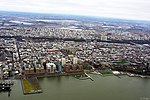Church of Our Lady of Grace (Hoboken, New Jersey)
19th-century Roman Catholic church buildings in the United StatesChurches in Hoboken, New JerseyChurches in Hudson County, New JerseyChurches on the National Register of Historic Places in New JerseyGothic Revival church buildings in New Jersey ... and 7 more
National Register of Historic Places in Hudson County, New JerseyNew Jersey Register of Historic PlacesNew Jersey Registered Historic Place stubsNew Jersey church stubsRoman Catholic churches completed in 1876Roman Catholic churches in New JerseyUnited States history stubs

The Church of Our Lady of Grace is a Roman Catholic church built between 1874 and 1876. It is situated in Hoboken, Hudson County, New Jersey, United States. It is a Gothic-style church designed by Francis G. Himpler and William J. Whyte. Located on the corner of Fourth St. and Willow St. in Hoboken, it was listed on the National Register of Historic Places in 1996.The exterior of the church was used for scenes in the 1954 film On the Waterfront.
Excerpt from the Wikipedia article Church of Our Lady of Grace (Hoboken, New Jersey) (License: CC BY-SA 3.0, Authors, Images).Church of Our Lady of Grace (Hoboken, New Jersey)
Clinton Street,
Geographical coordinates (GPS) Address Nearby Places Show on map
Geographical coordinates (GPS)
| Latitude | Longitude |
|---|---|
| N 40.742222222222 ° | E -74.034166666667 ° |
Address
10 Church Towers
Clinton Street
07030
New Jersey, United States
Open on Google Maps









